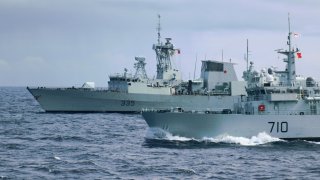Canada’s Defense Failures Put the Western Hemisphere at Risk
Among NATO members, Canada's lackluster defense spending and strategic planning stand out.
As the leaders of the North Atlantic Treaty Organization (NATO) descend upon Washington, DC, this week for the NATO Summit, one country stands out for its persistent failure to live up to the requirements of Alliance membership: Canada. Canada’s unwillingness to meet its basic NATO obligations not only imperils the Alliance’s traditional role as an upholder of stability in Europe but also, given the long-standing integration of Canadian and American defense in North America and emerging threats in the Arctic, Ottawa’s dereliction directly threatens the national security of the United States, as well.
Canada’s most recent budget seeks to reach 1.76 percent of GDP devoted to defense by 2029, up from 1.33 percent today yet still well below NATO’s pledge of 2 percent. Even this discouraging figure is deemed far too optimistic by Canada’s parliamentary budget officer, who predicts Ottawa will only reach 1.42 percent by the decade’s end and never exceed 1.49 percent during the period. Unlike the increasing number of NATO members that have now attained the 2 percent threshold, Canada has never even announced a timeline for meeting this minimum requirement to uphold the Alliance’s fundamental responsibilities.
Ottawa’s long-running failure to provide for a reasonable defense capability goes far beyond simply arbitrary spending numbers. A recent Canadian Defense Department report found that around half of the military’s current equipment is unusable, and the services face a combined personnel shortfall of roughly 16,000. Of the Canadian military components directly committed to undertaking NATO obligations, only 58 percent could actually enter combat if needed.
The Canadian Navy’s new surface combatant fleet is dramatically behind schedule and unlikely to be fielded until the early 2030s. Earlier this year, in response to a commitment made in 2010 to modernize its icebreaker fleet to address growing geopolitical challenges in the Arctic, Ottawa finally awarded a contract for such vessels. In response to criticism that his government has repeatedly failed to execute major procurement programs in a timely fashion, Prime Minister Justin Trudeau’s Liberal Party has pledged to make hiring additional civilian procurement specialists a priority.
The Canadian Department of National Defense has itself admitted that the Air Force’s aging fighters are “in crisis,” with insufficient trained pilots to crew incoming F-35 aircraft and the service’s current inventory of CF-18s. A senior Canadian general has warned that the Air Force is 2,500 active and reserve personnel short of requirements.
A substantial part of Ottawa’s defense challenge stems from strategic listlessness. Canada’s only National Security Policy was written in 2004 and never updated, while its newly formed National Security Council rarely convenes. These failures of strategic planning have real-world consequences. The Arctic, for example, is an area of comparative Canadian advantage, but Ottawa continues to underperform. As Russia has sought to reestablish its military presence throughout the High North, and the United States is adjusting its strategic and military focus to better address polar threats, Canada remains under-committed to developing the infrastructure, capabilities, and strategy necessary to serve as NATO’s principal Arctic defender.
Canada’s integration with the defense of North America, including the U.S. homeland through the North American Aerospace Defense Command (NORAD), makes Ottawa’s strategic morass more than academic for Washington. Not only does Ottawa’s under-resourcing of its defense and strategic malaise threaten NATO’s cohesion and deterrence capacity, both in the Arctic and Europe, more broadly, but it directly threatens American national security.
The United States relies on exceptional interoperability with Canadian aircraft and early warning capabilities, most notably demonstrated on September 11, 2001, to defend the continent. As Canada’s capacities atrophy, Washington will be forced to undertake additional domestic commitments for homeland defense rather than projecting power outward in pursuit of broader strategic goals like deterring China and Russia. Ottawa’s mismanagement of its defense requirements will ultimately contribute to the very American retrenchment that NATO’s most stalwart defenders bemoan.
Canadians have fought and died alongside American servicemen and women in two world wars and throughout the Cold War and its aftermath. The bonds of friendship and strategic alignment between Ottawa and Washington run deep. Yet the current trajectory of Canadian strategic and defense priorities is forcing an abrupt rupture with both NATO and the United States. Without an urgent refocus on its multilateral and bilateral defense commitments, Ottawa risks undermining the basis of the trans-Atlantic defense partnership and U.S. homeland defense. NATO leaders have an obligation to speak out strongly in support of a change in course.
Alexander B. Gray served as Deputy Assistant to the President and Chief of Staff of the White House National Security Council under President Donald Trump, 2019-2021.
Image: J. Csiki / Shutterstock.com.

